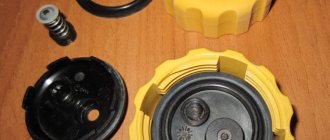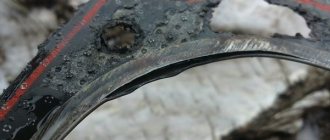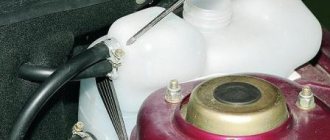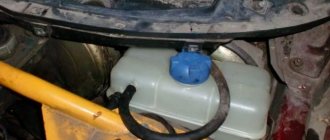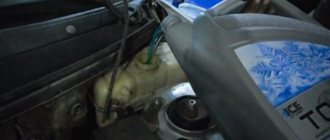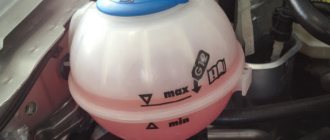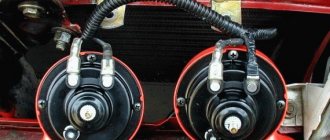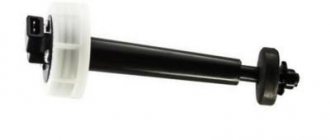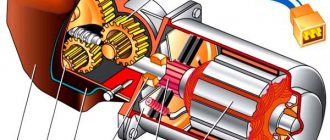What to do if the antifreeze is knocked out
First of all, it is necessary to localize the location of the leak.
Perhaps you will find the reason there. Most often (especially on cars with high mileage), flange connections simply collapse or hoses burst. High pressure coupled with temperatures under 100 °C will easily squeeze out an element worn out from age. After replacing a faulty unit, be sure to check the operation of the valve on the expansion tank cap. The valve on the cover cannot be restored, so the element must be replaced. If it can be disassembled, check the integrity of the spring and membrane. In some cases, removing dirt and crystals from mineral supplements is sufficient.
The gaskets are replaced with new ones; no restorative sealants will withstand pressure at high temperatures.
Triggering of the safety valve - causes and consequences
As just said, the reason why antifreeze is thrown out of the expansion tank of a VAZ 2114 is most often a leak in the engine cooling system. It leads to air leaks into the line or, conversely, prevents normal coolant circulation and cooling. This, in turn, causes the liquid in the tank to boil and be squeezed out through the safety valve of its lid.
Expansion tank cap for VAZ 2114
The main reasons for this may be:
- Factory defects in the tank.
- Microcracks in pipes.
- Blockages or cracks in the radiator.
- Water pump malfunction.
- Thermostat malfunction.
- Burnt out cylinder head gasket.
Inspection of the tank
You should start troubleshooting small, namely, by inspecting the tank, all hoses and pipes of the cooling system. If cracks or coolant leaks are noticed on them, they should be replaced.
Antifreeze presses out from under the lid of the VAZ 2114 tank
Main reasons
Expansion tank cap
There are several main reasons for the release of coolant through the expansion tank.
They are divided into several groups depending on what exactly the problems are associated with.
Similar phenomena occur on a variety of vehicles, including:
- VAZ 2114;
- Gazelle;
- KAMAZ;
- DAF;
- Lada Kalina;
- Nissan Almera;
- Mitsubishi Lancer;
- Hyundai Accent;
- Volkswagen Polo;
- Nissan Qashqai;
- Daewoo Lanos;
- Lada Granta;
- Mazda 6;
- Mercedes;
- Audi A5, etc.
The likelihood of encountering a similar problem is higher for cars with a higher mileage. Although we cannot rule out antifreeze emissions from cars that were only recently purchased and put into operation.
Let's look at the possible reasons separately.
Tank malfunctions
At first it may seem that the tank is designed extremely simply, and there simply cannot be any significant problems with it.
But it is because of the tank that the coolant most often begins to eject.
The seal is broken. Antifreeze has a high fluidity, which is why it can penetrate even through small cracks that are not visually noticeable. Thus, when the pressure increases, the liquid is squeezed out. Check for stains under the car after parking. It is best to completely replace the tank if there is leakage;
Defective threaded connections
When checking the expansion tank cap, pay attention to the threads of the neck and the valve itself. Cheap and low-quality products often have burrs and chips, which make a tight fit impossible.
An increase in pressure provokes coolant leakage through these channels;
Valve. The valve cover is also a common cause of fluid leaking from the reservoir. Moreover, the problem is quite easy to identify. Everything works fine at idle. But by increasing the speed, under load, the liquid is literally pushed out from under the valve. First try to disassemble and clean the element. If this does not help, the valve needs to be replaced.
But these are not the only possible reasons. Let's move on in search of the truth.
Coolant circulation is impaired
If circulation is disrupted, the fluid overheats greatly, pressure increases and coolant is squeezed out through the valve cover.
There are several reasons here.
The potential reasons don't end there
There is one more important point that is worth paying attention to
Leak formation
Most often, motorists are faced with a shortage of coolant in the cooling system. When the volume of antifreeze drops, the temperature rises as the engine cools. Heating leads to active evaporation and an increase in pressure.
If, when the engine cools down, the level remains unchanged in the tank, then you need to look for a problem in the circulation. And when the level drops, then the seal is broken. That means there is a leak somewhere.
There are several main probable causes of leakage:
- The pipes and hoses of the system are worn out and aged. They will need to be replaced, strengthening the new parts with additional clamps to increase the reliability of the connections;
- Cracks in the heater cores and cooling system. If the problem is in the stove, then antifreeze will leak into the cabin. Usually at the front passenger's feet;
- Problems with the pump and thermostat seals. Look for traces of antifreeze near those elements that act as suspects;
- The cylinder head gasket is broken. In this case, the cylinder head gasket will need to be replaced. The danger is that the coolant can penetrate the engine cylinders or lubrication system, mixing with the oil. The consequences can be extremely disastrous for the engine, including jamming of the internal combustion engine.
Now you are clearly convinced that there is nothing good in throwing out antifreeze through the expansion tank. When the first signs appear, be sure to stop the car, start looking for the causes and eliminating them.
If you have any difficulties with diagnostics or repairs, you can always contact a car service center.
Thanks everyone! Subscribe, invite your friends to join us and expect a lot of new and useful materials!
Remedies
Before starting repairs, you should figure out where and why the antifreeze is leaking, that is, make a diagnosis. Leaking hoses are easy to identify, as are fluid emissions from the tank - colored streaks are visible in the area of the lid. It’s more complicated with radiators - the holes in the pipes are usually small, they are blown by an air flow as they go, and leaks are invisible at first glance.
Advice. Fill the car's cooling system with antifreeze containing a fluorescent additive. It reflects the light of an ultraviolet lamp, making the slightest drips clearly visible.
Various problems can be resolved in the following ways:
- Try to clean and rinse the faulty valve of the expansion tank plug. If this does not help, the part should be replaced; it is inexpensive.
- A burst tank should be replaced. There is a practice of repairing plastic containers by soldering, but this option is not very reliable - the body may crack with the next pressure surge.
- Leaking hoses are definitely replaced. The exception is a crack at the very end, then the pipe is trimmed (if the length allows).
- A leaky pump seal must be replaced only on old Zhiguli VAZ 2101–07. On other cars it is replaced together with the water pump.
- Car radiators can be repaired if the cracks in the honeycombs are not the result of corrosion of the aluminum alloy. In any case, the unit must be removed and taken to a service center for inspection.
- A broken cylinder head gasket must be replaced immediately; you cannot drive with this damage. The work involves disassembling the engine; it should be entrusted to a master mechanic.
If one of the listed troubles happens to you on the road, you can add water to the cooling system to get to the garage or car service center. The exception is a gasket burnout, after which you cannot move on. Turn off the engine and tow the car.
The component that sooner or later fails for any car owner is the coolant. If antifreeze is thrown out of the expansion tank, it’s time to understand the internal structure of the car (if you haven’t already done so). That's what we'll talk about today.
Why does antifreeze squeeze out of the expansion tank?
G12 antifreeze, its features and differences from other classes of antifreeze
Often car owners are faced with the fact that antifreeze begins to squeeze out of the expansion tank. In this case, no visible reasons can be found (the pipes and the cover are intact, and after a long period of parking, no puddles appear under the car). In this case, you can diagnose what antifreeze is emitting through the expansion tank by measuring the refrigerant level or checking the following elements in a given order:
- expansion tank;
- engine radiator;
- stove radiator;
- thermostat housing;
- all possible joints and pipes;
- cooling system pump.
If antifreeze leaks, the causes and consequences may be more serious than it seemed, so it would not be superfluous to check the engine oil. A probe is used for this. If traces of light foam remain on it, this indicates that the refrigerant is mixed with oil.
If antifreeze goes into the engine, then you will find white spots on the spark plugs.
Upon closer examination, you will be able to identify one of the causes of leaks that form in different components.
Cooling system radiator
Carefully inspect the engine (it is better to wash the entire engine compartment first). One of the most common reasons is a leak in the cooling system components. In this case, the location of the problem is the radiator, which may have been pierced by a stone or other object thrown from under the wheels of oncoming traffic. If antifreeze is leaking from the radiator, then the plates are probably worn out, which were exposed to ethylene glycol, which is part of the antifreeze, for a long time. Or the tank itself is simply cracked, in which case it is enough to replace it with a new one. Some radiators are equipped with plastic tanks, in which cracks quickly form and, as a result, liquid leaks.
Heater radiator
If the radiator of the heating system is responsible for the leak, then a clear “aroma” appears in the car’s interior. In some situations, you may also find a sticky spot under the dashboard.
Important! If you begin to smell an unpleasant odor, solve the problem immediately, since refrigerant vapors are very harmful to the human body, especially if the antifreeze is made on the basis of ethylene glycol.
water pump
Another reason why antifreeze is thrown out of the expansion tank may be the pump, or more specifically, a worn out oil seal. It is very easy to identify this “disease”. To do this, carefully inspect the engine and if you find that there are wet areas in its lower part, then the “hero of the occasion” is definitely the pump.
Thermostat
A broken thermostat seal is also a possible cause of problems. In most cases, normal gasket wear occurs.
In addition to the loss of refrigerant, car owners are faced with other problems.
Signs of antifreeze getting into car oil
How to determine that antifreeze has entered the lubricant complex? This can be understood by the following signs:
- The amount of lubricant has increased and the coolant level has decreased. If the expansion tank quickly empties without leaks, look at the dipstick. Most likely, the liquid has already gone beyond the maximum mark.
- The shade of the grease changed from brown to darker. Pay special attention to this sign if you recently changed the oil product.
- Car oil has a heterogeneous consistency. Interacting with the coolant, the oil liquid becomes like an emulsion.
- The color of the exhaust has changed. When the coolant burns, the exhaust gases become light-colored. In summer, this sign is impossible not to notice.
- The functioning of the power unit has deteriorated. It begins to “triple”, as the emulsion clogs the oil channels and interferes with the proper operation of the engine.
If you find that the coolant is leaking into the lubricant, turn off the engine and find out the cause of the leak. Otherwise, you may have to overhaul your internal combustion engine.
Burst of hoses and damaged pipe is a problem that requires quick fix
What antifreeze to choose, choice by car make, orange antifreeze
For old cars with hundreds of thousands of miles on them, the problem of antifreeze leakage is most often worn out hoses. Over time, they lose their elasticity, crack and no longer withstand constant pressure. Its fastening at the junction also loses strength and weakens, which can lead to antifreeze leakage.
Advice! For preventive purposes, it makes sense to change the cooling system hoses after about 5 years of operation (for foreign cars - 10 years), and use screw clamps for fastening.
It is not difficult to find out that the hoses are the reason why the antifreeze quickly disappears. A careful inspection is enough. If obvious damage is clearly visible, then in order to identify small defects, you must first thoroughly rub all the hoses with a dry rag and run the engine at idle speed. After this, coolant leaks become clearly visible.
In some cases, it is necessary to carry out an operation to replace worn pipes. When performing this procedure yourself, you should follow certain recommendations:
- The car engine must cool completely;
- It is better to use a clean container to drain antifreeze, since it can be reused and can be poured back into the system;
- to make it easier to unscrew the clamps, you can lubricate them with a small amount of liquid oil or another product (for example, WD-40);
- after loosening the clamps, the pipe is carefully removed from the neck, remembering that almost all necks are quite fragile and easily damaged;
- Before putting on a new pipe, clamps are put on it;
- if difficulties arise when tightening a new pipe, you should not use any chemicals, it is only permissible to hold the pipe in hot water;
- The clamps are tightened tightly.
How to solve problems?
The problem can be solved by periodically inspecting the cooling system and identifying its weak points.
In order to prevent antifreeze from leaking on the VAZ-2110, you must constantly and regularly inspect the engine compartment in order to notice a leak of antifreeze in time. Also, do not use used parts, such as a lid or tank. You also need to buy new hoses.
We also need to stop using cheap antifreeze. It can negatively affect the density of rubber and plastic, which will lead to leakage and depressurization of the system.
What to do if antifreeze boils
If you notice that the antifreeze has begun to boil, it is better to identify the root cause as quickly as possible, as this will have a detrimental effect on the operation of the engine. Although the boiling point of antifreeze is higher than the boiling point of water, the refrigerant still periodically fails to cope with too heavy loads
There can be many reasons for this, for example:
- The coolant level has dropped to a minimum due to which the antifreeze in the expansion tank is boiling. In this case, it is enough to add refrigerant or water.
- The thermostat can also cause boiling if the valve that passes fluid through a large circle of the cooling system is broken. In this situation, it turns out that the antifreeze moves only in a small circle and does not physically have time to cool down, as a result of which it heats up to a high temperature and begins to boil. To identify such a problem, you need to check the temperature of two pipes; if one of them is cold and the other is hot, then the problem is clearly in the thermostat. A thermostat malfunction is a very serious failure, since when antifreeze circulates only through a small circuit, not only the antifreeze, but also the engine itself heats up, and this threatens to jam the piston group.
Advice! If the thermostat “flies” outside the city and there is no way to replace it, you can continue driving in small sections of 5 kilometers. After each section, allow the engine to cool completely.
- Problems that cause antifreeze to boil often lie in the radiator. The temperature of the antifreeze can reach the boiling point if the refrigerant forms sediment, resulting in clogging of the tubes. As a result, the large cooling circuit turns into a small one. It will be difficult to get rid of such a problem on your own, so it is better to contact a repair shop.
- The pump can also be fully responsible not only for the leak, but also for the boiling of antifreeze. If this element is completely out of order, then the refrigerant cannot fully move through the cooling system. As a result, the liquid boils and the motor overheats greatly.
How to fix a breakdown yourself
Repairs should always be preceded by preliminary diagnostics. First, the cause is clarified, and then the problem with antifreeze leakage is eliminated.
Problems in practice are usually resolved in one of the following ways:
- If the plug valve malfunctions, it is simply cleaned. It may even need to be replaced, which is quite expensive;
- If the tank bursts, then it is replaced with a new one or, at a minimum, soldered;
- Hoses are replaced if there is a leak in them. Only in case of bottom leakage, you can simply trim them a little;
- A hole in the pump seal requires replacing not only it, but also the water pump;
- A detected problem in the radiator allows repair work to be carried out. Service workers can check that the resulting cracks are not due to corrosion;
When a cylinder head gasket breaks, it is changed immediately, since it is impossible to use a car with such a breakdown.
If the problem is discovered during a trip, it is recommended to add water to the system. This is done in order to be able to get to the nearest service center. Except in cases of gasket burnout. Then the only way out is to call a tow truck.
A little about the problem
The expansion tank is an integral component of the internal combustion engine cooling system. The main task of this element is to dampen pressure fluctuations inside pipelines that arise as a result of a decrease or increase in the volume of cooling liquid when it is cooled and heated, respectively.
Such a capacity allows you to reduce mechanical loads on the entire cooling system. Thus, the internal combustion engine is protected from water hammer and air locks. Although they cannot be completely prevented, as a result, sometimes you have to figure out how to remove the airlock. Essentially, the tank replenishes the liquid deficit in the cooling lines and acts as a receiving tank when excess coolant appears, which occurs when the composition is heated. Structurally, it is a seemingly ordinary sealed plastic tank.
An integral element of the unit is the expansion tank cap, which also serves as a valve. With its help, pressure enters the tank from the outside when there is a deficiency in the system, or excess pressure is released.
When the coolant heats up, the liquid gradually expands, thereby filling the tank space. In parallel with the increase in evaporation from heating, the internal pressure increases.
For various tank designs and specific car engines, along with their cooling system, certain threshold pressure values are provided. When they are reached, a valve begins to operate, which expels excess pressure from the system. But there are situations when the antifreeze is already boiling, the pressure increases, but it does not release. Instead, it throws out the liquid itself. That is, the valve does not cope with its tasks. Why this happens and how to deal with it is the key question of this material.
Moreover, emissions can appear after the engine is stopped and during operation of the power plant. Let's understand the reasons.
Consequences of throwing away antifreeze
If you do not take any measures to eliminate the malfunction and continue driving, the consequences of such driving can be quite serious. If the antifreeze is squeezed out of the tank to a level below the minimum, the engine will simply overheat.
The consequences of engine overheating are very sad. As a rule, the cylinder head gasket is the first to suffer. It consists of a material that is susceptible to high temperatures and burns through, losing its properties. Antifreeze gets into the engine crankcase and makes the oil too liquid. Such a mixture will no longer be able to provide reliable lubrication of the components and then jamming of the mechanism or water hammer occurs.
If the coolant is completely squeezed out, the engine oil will not be affected. However, many elements of the cylinder head can react negatively to an increase in temperature, which become deformed and disrupt the operation of the mechanism. As a result, the engine loses its power or does not start at all and then it will require expensive repairs.
Some tips on what to do if antifreeze boils on the road
How to fix an antifreeze leak, if you find yourself in the middle of a highway or there is no car service or auto parts store nearby, the first thing that comes to mind is to add water to the antifreeze. This can really save the situation, but you need to be extremely careful with this operation. Never open the expansion tank cap until the engine has completely cooled down. Otherwise, boiling liquid may splash onto your hands and body, causing severe burns.
If while driving you notice a jump in the antifreeze temperature, you can temporarily solve this problem without stopping. To do this, you need to cool the car interior as much as possible by opening the windows and turning on the heater fan. Thanks to this, you will be able to slightly lower the temperature of the antifreeze and reduce the load on the engine.
If the overheating light starts blinking and the temperature rises to a critical point, it is better to stop immediately and prevent the engine from boiling. It is not recommended to move further in such a situation; wait for a tow truck or ask someone to take you in tow.
KAMAZ Euro throws out antifreeze
A client arrived with a complaint about the constant release of antifreeze from the expansion tank, we are looking at the possible causes of the breakdown and ways to eliminate them.
Comments
How to check on Euro 2 there are sensors on one side, thanks in advance. I’m not a driver, I bought a Kamaz and I’m tormented by doubts
Disassemble the water jacket and look at the heads.
It cuts in that direction because the temperature there is always higher since the exhaust is in that direction, that is, the manifold. The gasket is not very comfortable there
Nice video, very useful, thank you, I’ll have to try that too
Between the right and left water manifold, instead of a tube, I put the upper radiator pipe. shortening it a little and using clamps. it's faster, simpler, more reliable and cheaper.
We also install according to the client’s wishes!
Hello Zhenya, are you giving me a new cylinder, because the old geometry is broken and the issue cannot be closed with plasticine, but repeated repairs at your own expense, or will the owner continue to fuss, because it’s clear that the filk’s letter will break again under load?
Zheka salam! Kamaz Euro2, when you give it gas, the antifreeze rises to the top in the tank and throws it out. how to look for the reason
That's what he showed in the video.
I once had a liner changed a long time ago without removing the pan. Quickly.
@Zheka Saltovsky I understand
The sleeve needs to be sharpened by a turner; it’s easier for me to remove the pan.
Yes, and tell me, if I’m idling for at least half a day, nothing drives or presses, but even a small slide, the scribe drives out 10 and 15 liters of antifreeze, the flag and the thermostats are changed
Zheka Saltovsky thank you
These are not thermostats and a flag, you need to look for gas leaks!
Hi guys. Simply handsome. For a beginner like me, this video is worth its weight in gold. And make such detailed videos more often. Thanks, I’ll go try it on mine and see if it works. By the way, does the valve need to be adjusted or left as is?
Zheka Saltovsky valve of the head that he removed and changed gaskets
Hello! I checked it as in the video, there is no antifreeze pressure from the sensors, but 3-4 liters are consumed per day. It's dry under the car and the oil level on the dipstick is normal.
Unscrew the plugs on the filters, will water come out?
How about in Eureka?
Are there no sensors on the sides of the water jacket?
Zhen, what will he do if the sleeve bursts?
@Zheka Saltovsky, you had water thrown out of your water jacket, and I had bulbs from my water jacket. What could it be?
Throw it into a barrel and there might be a water hammer!
throw out the head and install a new one, it’s just squashed, I had this happen))
This check did not help me, I can’t find it, I fill a full tank of water, start it cold, and it presses from the tank like from a tap until the tank is half empty, and while driving it throws antifreeze to the rear wheels, removed the sensors, presses water from driver's side, removed the water manifold, started it, nothing happens, no water pressure, but when I unscrewed the sensor from the thermostats, there was a puff of air
Then lift the entire driver's side, since there was pressure from there and should show the problem on your head!
Well, what is the small circle for?) It also throws when cold, and according to the sensor the temperature is normal, the engine is the most normal 740.10
Maybe they got stuck and didn’t open!
yes, now I also removed the heads on one side, to no avail everything is fine there, I threw out the thermostats altogether, it seems that now the water is running normally, after the flight I’ll find out whether it’s throwing or not, I don’t even know what to look for anymore
This is also better for the engine; you won’t overheat it while you’re looking for it.
Zheka did everything right, well, it was also necessary to pull out the injectors one by one to find which cylinder to change either the head or the cylinder, well, more often than not, it’s the liner and the head that rarely flies
Of course, I don’t want to make Zheka look like a stupid person, but judging by HIS words, gas doesn’t go up, but on the contrary, it always goes down. Guys, gas is not a liquid - it has no top and bottom, if it starts to cut from under the gas joint ring of the cylinder head, then gases under great pressure they will come out to the outside, in the place where the split is. But it won’t go either down or up, especially under the BOCHATA, which are pressed down by the head itself and they are generally separate from the gasket-boot. And if there is gas, then most likely there are cracks or microcracks in the cylinder head itself. This is checked either by replacing the cylinder head or by pressure testing, a labor-intensive process, but possible. EVERYTHING I said was verified by personal experience, although I did not test the heads, but simply replaced them with others.
We did this and there’s nothing we can’t determine, well, it’s true that Euro 3 and 4 breaks through when in the intake or vent valve, it’s only for dampness or pressure testing
How to remove an air lock from the cooling system Simple methods
- After filling or adding new fluid;
- Due to depressurization of connections or pipes of the cooling system;
- The seal of the pump is broken due to worn seals and gaskets;
- Sticking air valve in the expansion tank;
- Mechanical damage due to an accident or traffic accident;
- Deformation of the polymer material due to constant elevated temperature;
- The cylinder head gasket has blown.
Drive the car onto a flat surface or inspection hole, squeeze the handbrake, turn on neutral; Using a jack, lift the front of the car about 35-45 cm from the surface; Open the expansion tank cap
Be careful, as careless handling may result in burns; Start the engine and stove radiator with the temperature set to maximum; Carefully begin adding antifreeze or antifreeze to the expansion tank to the maximum; Increase engine speed to 3000 rpm; Wait until the thermostat opens and begin to squeeze the lower pipe leading to the radiator with your hand. Be careful, carry out the procedure with gloves, following safety rules; Continue doing this until you are sure that the liquid coming out of the expansion tank is clean, without air bubbles; Check the entire lower part of the pipes with your hands, make sure they are hot; Start the stove heater with radiator
Check the supply of hot air flow into the car interior; Lower the car from the jack, secure it with boots for safety; Add the missing amount of refrigerant at a level above average. Never fill at the top level as this may cause expansion and overflow of the lid. Antifreeze particles will corrode the car's paintwork over time; If the airiness is severe, a repeat procedure may be necessary. See this for yourself.
- Drive the car onto a flat surface or inspection hole, squeeze the handbrake, turn on neutral;
- We do not turn off the engine, but warm it up to a temperature of 90°C when the thermostat opens and the liquid begins to circulate in a large circle;
- Do not open the expansion tank cap;
- We turn off the engine;
- Loosen the clamp on the throttle body pipe and remove the pipe. Be very careful and attentive, as temperatures above 90°C can cause burns. Carry out work only with rubber gloves;
- Having removed the rubber hose, wait until all the air mixed with antifreeze or antifreeze comes out of it;
- We put the pipe back on, clamp the clamp;
- We start the engine and test the car. It is advisable to drive both on the highway and around the city at low speed to recheck the system in full.
AutoFlit.ru
Signs of antifreeze getting into the cylinder block
The main sign of a violation of the circulation of coolant in the engine is a regular decrease in its level in the tank. Antifreeze can leave the tank for other reasons, but if such a situation is noticed, you should pay attention to other signs. If a car owner notices one or more of the above symptoms, there is a possibility of antifreeze leaking into the cylinder block.
- White smoke from the exhaust pipe with the characteristic smell of burnt antifreeze.
- The presence of a white emulsion in the oil. A white coating is noticeable on the filler neck or on the dipstick when checking the oil level.
- Soot or wet residue on one or more spark plugs. When antifreeze penetrates into the cylinder block, the spark plugs also acquire its smell.
- The engine starts to stall and runs unevenly. In jerks.
- Bubbles appear in the expansion tank.
- The oil darkens quickly.
- White smoke may appear. It comes out of the exhaust pipe and looks like steam.
What kind of liquid is in the expansion tank?
Inexperienced motorists may not know what an expansion tank is and what the specific color of liquid with which it is filled is needed for.
Antifreeze, or antifreeze as everyone also calls it, is a liquid that is designed to maintain a comfortably low temperature inside a car engine. Protects internal parts and systems from corrosion, overheating, rust and freezing. That is, it maintains the normal operation of the vehicle.
If antifreeze is released from the expansion tank, the engine and many other vehicle systems will not be able to operate normally.
In the article we will look at the main reasons, consider the signs of fluid ejection and, accordingly, tell you what you need to pay attention to so that your car is always in good condition and does not let you down at the most unexpected moment.
Antifreeze is leaving - main and side signs
Now everything is clear with the reasons, but how can you understand that coolant is being thrown out of the system? Antifreeze evaporates very quickly, so it is not always possible to catch traces of it, especially if it leaves in small quantities . Of course, when a lot of liquid is squeezed out through the expansion barrel at once, characteristic puddles will remain on the asphalt. Well, in general, you just need to observe the behavior of your “iron horse”; it will indicate in the best way possible a particular malfunction.
Coolant circulation is disrupted
If circulation is disrupted, the fluid overheats greatly, pressure increases and the coolant is forced out through the valve cover. There are several reasons here.
- Thermostat malfunction. If the thermostat does not work, then the liquid will flow only in a small circle, bypassing the antifreeze cooling radiator. In this situation, the motor will overheat. It is necessary to check and, if necessary, change the unit;
- Air lock or clogged channels. Blockages appear due to scale, mechanical debris, improper mixing of antifreeze, etc. This is where the radiator is cleaned and flushed;
- Water pump failure.
[custom_ads_shortcode1]
Diagnostics
Antifreeze evaporates quickly, especially on a hot engine, which makes it difficult to identify the location of its leak. If a large amount of antifreeze leaks out, it is easier to spot the leak.
- When antifreeze leaks in the cabin, this indicates a malfunction of the stove. It needs to be changed. Faucets can also leak.
- If antifreeze gets into the combustion chamber, it will cause water to appear on the exhaust pipe, and the smoke itself will turn black. In this case, the gasket in the block is faulty.
- Tightness of fittings. It is necessary to carefully examine them, especially in the area of the tank. Often in a VAZ-2110 antifreeze can leak from the bottom of the tank where the pipe is attached.
All these malfunctions are accompanied by engine overheating and boiling of the liquid in the cooling system. Its temperature can usually be determined using a sensor on the instrument panel.
[custom_ads_shortcode1]
Real cases of malfunctions.
Oleg, VAZ 2114:
I noticed that when the engine is running, even to warm up, antifreeze presses through the plug. The fluid level also dropped, so I had to top it up periodically. I started looking for the problem. It turned out that the pump was at fault. Upon inspection, I saw that the timing belt protective cover was wet from the inside, and threads appeared on the block on the timing side. Thanks to the broken gasket of the water pump, the casing and block were splashed, and at high speeds after the engine warmed up, the coolant almost boiled and was thrown out through the valve. Since I took the car by hand, I didn’t bother to rebuild the pump - I installed a new one, now it doesn’t throw away and it’s dry.
Nikolay, Gazelle 4216:
There is a problem. Gazelle 4216, UMZ engine, new thermostat. When the engine warms up, everything is fine, it reaches operating temperature and the antifreeze begins to flow through the plug. The engine never overheated. I thought it was a crack in the head, but the oil level is normal, the antifreeze is clean, the fan works like a charm. Replacing the valve cover did not help. A thorough search for the cause at the service center showed that the gasket in the cylinder head had broken. The master said that the disease is known - it needs to be polished a little. It can be worse - often there are microcracks in the head, the beam should be changed immediately.
Peter, Chevrolet Niva:
I noticed that coolant drips constantly appear around the plug and under the reservoir on the body. I read descriptions of faults on the Internet and started looking everywhere I could. I didn’t find it - everything is normal, but the streaks remain. I took the car to the service center.
The master enlightened me - it turns out that this is a common occurrence on this machine. When the pressure is released, especially when the engine is warm, the antifreeze flows out in an intense stream with splashing. As a result, some of the coolant splashes out. The process is repeated constantly when driving, splashes appear through the hole in the plug and numerous drips appear.
He solved the problem in literally 2 minutes - he inserted a piece of brake pipe into the hole where the fluid comes from and directed it to the bottom. I’ve been happy for a week now – everything is dry.
Alexey, VAZ 2107:
For several days, a distinct smell of antifreeze appeared in the cabin. An inspection under the hood showed that the reservoir was wet. I started to see what was happening. You add gas - the level is in place, at idle it steadily creeps up. I turned it off again and the antifreeze began to leave the container. I felt the pipes - they seemed to be in order. The service department said that the thermostat died. I changed it, but the antifreeze still rose into the reservoir at idle. I was puzzled, because I had just recently changed the pipes, the cooling radiator and heaters, the pump, the cylinder head gasket - I installed everything new.
It was not possible to resolve the issue on our own; we had to turn to specialists again. They were smart for almost a week (and it was in this service that they changed everything for me). It turned out that when they changed the cylinder head gasket, they did not pay attention to the surface; when tightening it, it was pressed through. They removed the head, sanded it, replaced the gasket with a new one, carefully installed it and tightened it - the problem was gone.
